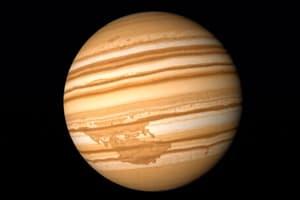Podcast
Questions and Answers
Which planet is characterized by having 687 Earth days to orbit the sun?
Which planet is characterized by having 687 Earth days to orbit the sun?
- Mars (correct)
- Earth
- Venus
- Mars and Venus
What is a distinct feature of Mars' polar regions?
What is a distinct feature of Mars' polar regions?
- Magnetic fields
- Highest mountains
- Polar Icecaps + Frozen CO2 (correct)
- Canyons and valleys
Which planet has the largest inactive volcano, Olympus Mons?
Which planet has the largest inactive volcano, Olympus Mons?
- Earth
- Mars (correct)
- Jupiter
- Venus
What is the duration of Mars' rotation period on its axis?
What is the duration of Mars' rotation period on its axis?
Which planet has no magnetic field?
Which planet has no magnetic field?
What is a notable feature of Mars' geography?
What is a notable feature of Mars' geography?
What is the characteristic of the atmosphere of Neptune?
What is the characteristic of the atmosphere of Neptune?
What is the duration of Neptune's rotation on its axis?
What is the duration of Neptune's rotation on its axis?
What is the characteristic of the magnetic field of Mercury?
What is the characteristic of the magnetic field of Mercury?
How many moons does Neptune have?
How many moons does Neptune have?
What is the characteristic of the rings of Neptune?
What is the characteristic of the rings of Neptune?
What is the characteristic of the terrestrial planets?
What is the characteristic of the terrestrial planets?
What is the characteristic of Earth's atmosphere?
What is the characteristic of Earth's atmosphere?
What is the orbital period of Neptune around the sun?
What is the orbital period of Neptune around the sun?
What is the unique characteristic of Jupiter's rotation?
What is the unique characteristic of Jupiter's rotation?
What is the composition of Jupiter's atmosphere?
What is the composition of Jupiter's atmosphere?
What is the characteristic of Jupiter's moon, Io?
What is the characteristic of Jupiter's moon, Io?
What is the characteristic of Jupiter's Great Red Spot?
What is the characteristic of Jupiter's Great Red Spot?
What is the characteristic of Saturn's size?
What is the characteristic of Saturn's size?
What is the characteristic of Saturn's rotation?
What is the characteristic of Saturn's rotation?
What is the characteristic of Jupiter's orbit?
What is the characteristic of Jupiter's orbit?
What is the characteristic of the Jovian planets?
What is the characteristic of the Jovian planets?
Flashcards are hidden until you start studying
Study Notes
Neptune
- Has 27 moons with diverse landforms, deep canyons, and craters
- Has a ring system with at least 9 distinctive ring belts
- Mass is same as Uranus
- Takes 60,000 Earth days to orbit the sun
- Rotates on its axis in 16 Earth hours
- Has cirrus-like clouds made of frozen methane
- Has 13 to 28 moons
- Has a large rotating storm called the Great Dark Spot, which vanished a few years after discovery
- Has thin and dark rings
Terrestrial Planets (Inner Planets)
- Include Mercury and Earth
- Characteristics of Mercury:
- Has very little atmosphere
- Has a faint magnetic field strong enough to deflect solar winds
- Characteristics of Earth:
- Has a thin atmosphere composed of O2, N2, and little CO2
- Has a magnetic field generated by its outer core
Jupiter
- Characteristics:
- Largest planet in the solar system
- Bright enough to be visible with the naked eye
- Mass is 2.5 times greater than the mass of all other planets and moons combined
- Takes 4332 Earth days to orbit the sun
- Rotates on its axis in less than 10 Earth hours
- Has a hydrogen and helium atmosphere with small amounts of ammonia and methane
- Is thought to be a gigantic ocean of liquid nitrogen
- Has 64 to 85 moons
- Has a ring system made of fine dark particles similar to smoke
- Has a large storm known as the Great Red Spot, which can fit 3 Earths inside and has speeds of 430 to 680 km/h
Historical Fact
- All planets in our solar system are named after Roman gods or characters, except for Earth
Saturn
- Characteristics:
- Size and volume are 764 times larger than Earth's
- Takes 11,000 Earth days to complete one orbit around the sun
- Rotates on its axis more than twice for every one Earth's rotation
- Has 3rd place from the sun
- Has polar icecaps and frozen CO2 at the north and south poles
- Has 2 natural moons
- Takes 687 Earth days to orbit the sun
- Rotates on its axis in 25 Earth hours
- Has no magnetic field
Mars
- Characteristics:
- Has the largest inactive volcano, Olympus Mons, which is 2.5 times higher than Mount Everest
- Has canyons and valleys, including the Valles Marineris, which is over 5000 km long and up to 8 km deep
- Has a thin atmosphere
- Has a magnetic field
- Has the highest mountain, Mount Everest
Studying That Suits You
Use AI to generate personalized quizzes and flashcards to suit your learning preferences.




